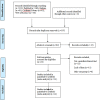Comparison of dynamic and static spacers for the treatment of infections following total knee replacement: a systematic review and meta-analysis
- PMID: 35840986
- PMCID: PMC9284771
- DOI: 10.1186/s13018-022-03238-7
Comparison of dynamic and static spacers for the treatment of infections following total knee replacement: a systematic review and meta-analysis
Abstract
Background: Revision surgery is the most common treatment for patients who develop infection after total knee arthroplasty (TKA). Two types of spacers are often used in revision surgery: dynamic spacers and static spacers. The comparative efficacy of these two types of spacers on knee prosthesis infections is not well established. Therefore, we carried out a systematic evaluation and meta-analysis with the aim of comparing the difference in efficacy between dynamic and static spacers.
Methods: We conducted the literature search in PubMed, Web of Science, Cochrane Library, and Embase databases. The articles searched were clinical study comparing the difference in efficacy between dynamic spacers and static spacers for the treatment of prosthetic infections occurring after total knee arthroplasty.
Results: We conducted a literature search and screening based on the principles of PICOS. Ultimately, 14 relevant clinical studies were included in our current study. We use infection control rate as the primary evaluation indicator. The KSS knee scores (KSSs), KSS functional scores, bone loss and range of motion (ROM) are secondary indicators of evaluation. Thirteen of these included studies reported the infection control rates, with no significant difference between dynamic and static shims (RR: 1.03; 95% Cl 0.98, 1.09; P = 0.179 > 0.05). The KSSs were reported in 10 articles (RR: 5.98; 95% CI 0.52, 11.43; P = 0.032 < 0.05). Six articles reported the KSS functional scores (RR: 13.90; 95% CI 4.95, 22.85; P = 0.02 < 0.05). Twelve articles reported the ROM (RR: 17.23. 95% CI 10.18, 24.27; P < 0.0001). Six articles reported the bone loss (RR: 2.04; 95% CI 1.11, 3.77; P = 0.022 < 0.05).
Conclusion: Current evidence demonstrates that dynamic spacers are comparable to static spacers in controlling prosthetic joint infection. In terms of improving the functional prognosis of the knee joint, dynamic spacers are more effective than static spacers.
Keywords: Dynamic spacers; Meta-analysis; Periprosthetic joint infection; Static spacers; Total knee arthroplasty.
© 2022. The Author(s).
Conflict of interest statement
The authors declare that they have no competing interests.
Figures
Similar articles
-
Comparison of the efficacy of static versus articular spacers in two-stage revision surgery for the treatment of infection following total knee arthroplasty: a meta-analysis.J Orthop Surg Res. 2017 Oct 17;12(1):151. doi: 10.1186/s13018-017-0644-6. J Orthop Surg Res. 2017. PMID: 29041970 Free PMC article.
-
Treatment of Periprosthetic Knee Infection With a Two-stage Protocol Using Static Spacers.Clin Orthop Relat Res. 2016 Jan;474(1):120-5. doi: 10.1007/s11999-015-4443-2. Clin Orthop Relat Res. 2016. PMID: 26280681 Free PMC article.
-
Comparison of infection eradication rate of using articulating spacers containing bio-inert materials versus all-cement articulating spacers in revision of infected TKA: a systematic review and meta-analysis.Arch Orthop Trauma Surg. 2019 May;139(5):695-707. doi: 10.1007/s00402-019-03121-x. Epub 2019 Mar 8. Arch Orthop Trauma Surg. 2019. PMID: 30850888
-
Functional outcome of two-stage reimplantation in patients with periprosthetic joint infection after primary total knee arthroplasty.Int Orthop. 2019 Nov;43(11):2503-2509. doi: 10.1007/s00264-019-04296-z. Epub 2019 Jan 16. Int Orthop. 2019. PMID: 30652221
-
Indications and techniques for non-articulating spacers in massive bone loss following prosthetic knee joint infection: a scoping review.Arch Orthop Trauma Surg. 2023 Sep;143(9):5793-5805. doi: 10.1007/s00402-023-04893-z. Epub 2023 May 9. Arch Orthop Trauma Surg. 2023. PMID: 37160445
Cited by
-
Review of recent advances in the diagnosis and management of periprosthetic joint infection after total knee arthroplasty part 2: single-stage or two-stage surgical technique?J Orthop Surg Res. 2024 Oct 12;19(1):643. doi: 10.1186/s13018-024-05152-6. J Orthop Surg Res. 2024. PMID: 39395987 Free PMC article. Review.
-
Outcomes of Antibiotic-Impregnated Calcium Sulfate, Reamer-Irrigator-Aspirator, and Locked Intramedullary Static Spacer in the Treatment of Periprosthetic Joint Infection in the Multiply Revised and Infected Knee: A Single-Center Case Series.Arthroplast Today. 2024 Apr 24;27:101370. doi: 10.1016/j.artd.2024.101370. eCollection 2024 Jun. Arthroplast Today. 2024. PMID: 38690098 Free PMC article.
-
Mechanical Complications of Hip and Knee Spacers Are Common.Cureus. 2023 May 3;15(5):e38496. doi: 10.7759/cureus.38496. eCollection 2023 May. Cureus. 2023. PMID: 37273394 Free PMC article.
-
The Creation of Articulating Cement Spacer Using Custom-Fabricated Silicone Mold for the Treatment of Periprosthetic Joint Infection: Two Case Reports.Cureus. 2022 Dec 6;14(12):e32254. doi: 10.7759/cureus.32254. eCollection 2022 Dec. Cureus. 2022. PMID: 36620812 Free PMC article.
-
Acetabular Screws With Cement Augment for Tibial Plateau Defects in Dynamic Spacer Implantation: A Case of Recalcitrant Native Knee Septic Arthritis.Arthroplast Today. 2024 Jun 17;28:101437. doi: 10.1016/j.artd.2024.101437. eCollection 2024 Aug. Arthroplast Today. 2024. PMID: 38983941 Free PMC article.
References
Publication types
MeSH terms
Grants and funding
LinkOut - more resources
Full Text Sources
Medical








